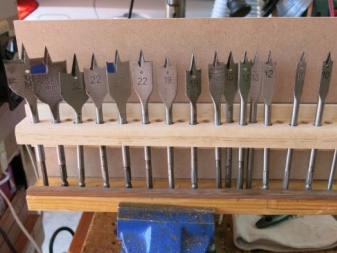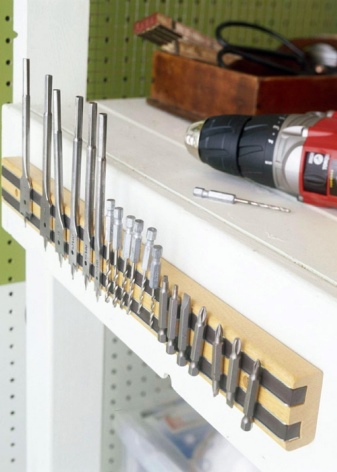All about storing drills

Drills, like any other, even the most durable tools, can become unusable. This happens for various reasons - ranging from improper use and ending with trivial wear and tear of the product. However, the service life of drills can be increased by proper storage. Read about how to do it correctly and what you need to pay special attention to in this article.


Basic storage rules
Drills are cutting tools. Their main task is to cut holes on various kinds of surfaces.... Most often, drills are made from steel or other strong alloys. The determining factors for the storage of drills are the material of manufacture and the method of heat treatment of products. Nevertheless, Signs of improper storage of tools are most often the adhesion of debris to the products, beating of the blades, and more.
The corners are the weak point of the drill - they are the first, unlike all other parts of the tool, to break off. Storage in separate tanks also means that the potential for various types of work-related injuries is significantly reduced. It is also worth noting that one of the significant advantages of various storage devices for drills is the ability to easily carry them. This becomes especially important when moving.
When the tools are laid out in a certain order, the speed of work also increases.


Varieties of devices
The main task of cases, boxes, cases and other holders for drills is to conditionally isolate drills from other tools, and sometimes from each other so that they do not rub against each other, which, as a rule, leads to dullness of the tools. The most famous and common containers for storing drills are these.
- Pencil cases. They are a convenient solution for storing drills in cars or when moving. Doesn't require a lot of space. Cases (soft pencil cases) can also be included in this category. The drill case can be used when hiking or transporting small amounts of tools. There are also special portable bags for storing and transporting drills.


- Various wood coasters. Most often they are a three-layer construction. Holes-cells are drilled in the two upper layers. Drills are inserted into them. The bottom layer plays the role of the bottom. The cells have different diameters. There is a wide variety of wooden coasters. They are durable. It is important to keep an eye on the surface finish of the wood if you are making your own wood stand. Otherwise, the service life of the wooden product will be significantly reduced.


- Plexiglass boxes... They look like pencil cases, but there are, as is obvious, only transparent. The main thing when buying or making it yourself is to check the durability of the lock.


- Organizers. Usually they are two or three parallel plates with holes of different sizes. The dimensions of the holes must correspond to the cross-sections of the tools that will be stored in them. The plates can be fastened together with one wall in the form of the same plate. This can also include plastic boxes. Sometimes they can be several cells into which drills can be inserted in a vertical position. In this case, the tools will not be isolated from each other, but will be sorted by size or frequency of use.

- Suspended structures. They are perhaps the most modern of all the species described here. However, the method of attachment to the surface and the structure of the surface must be considered. These holders are obviously best attached by screwing them to the surface with nails. If the surface of the walls is covered with tiles or other similar materials, then the mounting method must be changed. And also, especially with self-assembly, it is imperative to take into account the bearing capacity of the structure. For some curtain walls, it will be enough to fix it with epoxy glue on the wall surface. The very basis of such structures is of two types - solid and perforated.
The latter are considered a more convenient and practical option, since, thanks to the holes located on the perforated panel, it is always possible to remove or hang new fasteners.


- Tool cabinets. They are distinguished by their large dimensions. There are several subspecies - they can be mounted, stationary (similar to a regular chest of drawers or drawers), mobile (a chest of drawers on wheels) and others. Provides the safest storage tank for drills. There are combined models - hanging cabinets, which are a panel with shelves fixed to it.


- Tubes... They are suitable for storing any long and thin objects and tools. Most often they are stored together with the same tubes on extensive shelves. As a rule, tubes are used only when there is a lack of free space. Tubes can be made of metal and plastic.

It is worth clarifying that almost all, not only the last of the varieties mentioned here, can be both portable and stationary.
All models produced now can be equipped with various parts - magnetic locks, fasteners, rollers, as well as other various movable elements that make use more convenient.


What is the best way to store it?
One of the main factors in this case is the number of drills. If there are a large number of tools, then a cabinet would be the best option. If you have several drills at your disposal, then you can store them in a small organizer (the cheapest, most convenient and affordable option). An excellent solution for a very large number of tools can be a multistage rotating organizer, where each step will be made in the shape of a circle with holes for drills. The easiest way is to build one yourself.
If you plan to store drills together with other tools, it is also recommended to stop at purchasing or making your own cabinet. The main thing in this business is to think over and choose the internal structure of the cabinet that suits you. A convenient option is to merge the two types of drill storage tanks. Such as, for example, a small organizer with holes in the cassette case, a wooden drawer and a case with horizontal indentations for each drill, and other options.
One of the not entirely rational, but rather popular "devices" for storing such tools are various jars - glass, canned food, coffee and others. This storage method is considered obsolete, as well as inconvenient and insecure. For those who do not want to bother with a stand, the best solution is a portable suitcase, which is usually sold with a set of drills.

Advice
Traditionally, the most convenient option is considered to be a wooden stand hung on the wall in the workshop. Thus, you can not only store the tools, but also arrange them in easy accessibility. You also need to carefully consider the number and size of the holes if you are going to use an organizer for storage and even plan to make it yourself.
The universal holder that takes up little space and can also fit into any room is hinged construction. The magnetic holder is also very convenient. A thin magnetic strip is installed along one long section of the board. You can store on it not only drills, but also other tools. Such a structure will be relatively safe for children, since it can be suspended and fixed at the required height. It can also be a convenient option for the garage, as the tools will be available.
Renovation professionals recommend not dwelling on one drill storage option, but rather try several to see what works best for you.


For information on how to make an organizer for drills with your own hands, see the next video.













The comment was sent successfully.